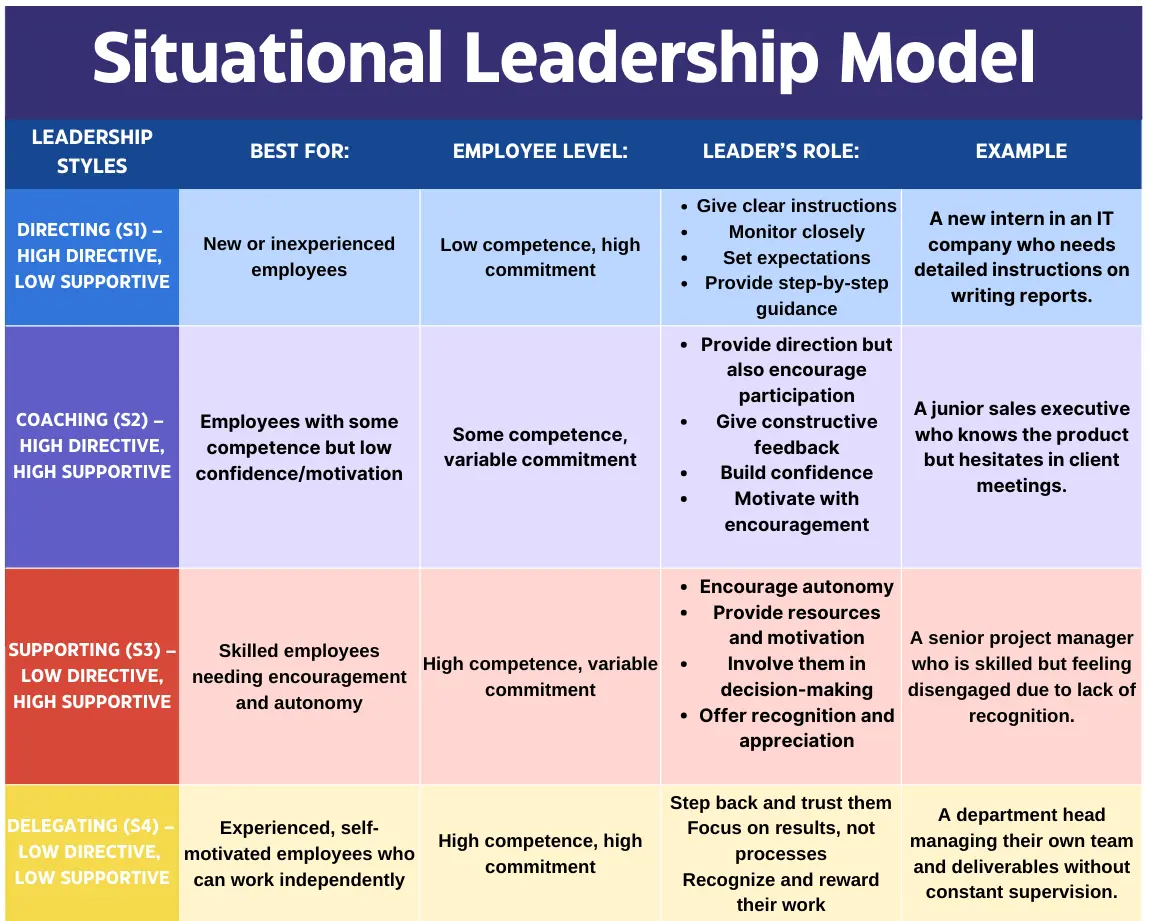One Leadership Style Doesn’t Fit All: Mastering Situational Leadership


Are You Leading Wrong? Why One-Size Leadership Doesn’t Work
Imagine this: You’ve just promoted your best-performing employee to a managerial role. She’s smart, driven, and knows the job inside out. But three months in, she’s struggling. Deadlines are slipping, the team is disengaged, and she seems frustrated. You wonder—did I make a mistake?
Now flip the scenario. You hire a fresh graduate full of energy but with no experience. You assign him tasks, but he keeps coming back with basic questions. Instead of taking ownership, he hesitates. You feel like you’re spoon-feeding him, and it’s slowing down work.
Two different people. Two different struggles. But here’s the question—did they fail, or did you fail to lead them the right way?
The Myth of One-Size-Fits-All Leadership
Many managers believe they must be either a strong, directive leader or a supportive, empowering one. Some think their leadership style should remain consistent to establish their identity. But what if I told you that great leadership isn’t about sticking to one style, but about adapting to the situation?
This is where the Situational Leadership Model by Paul Hersey and Ken Blanchard becomes a game-changer. It doesn’t tell you who you should be as a leader. Instead, it helps you decide how you should lead based on your team’s needs at that moment.
What is Situational Leadership?
Hersey and Blanchard’s model suggests that there is no single best way to lead. Instead, effective leadership depends on two key factors:
- Competence – How skilled or knowledgeable the individual is for the task.
- Commitment – How motivated or confident they are in doing it.
Based on these two factors, employees fall into four categories (called ‘development levels’), and each requires a different leadership approach.
The Four Situational Leadership Styles (with Indian Workplace Examples)
- Directing (S1) – When handholding is needed
Best for: New hires, freshers, or employees in a new role.
Example: Imagine you’ve hired a junior analyst in your finance team. It’s their first job, and they don’t know the company processes. If you just tell them, “Figure it out,” they’ll likely make mistakes or feel lost.
Leadership Action:
- Be clear, specific, and directive.
- Break down tasks into smaller steps.
- Monitor progress closely.
- Give frequent feedback and instructions.
- Tip: Think of this as training someone to drive. Initially, they need detailed guidance, but as they gain confidence, you ease off.
2. Coaching (S2) – When guidance + motivation is needed
Best for: Employees who have some skills but lack confidence or motivation.
Example: A sales executive in your team knows how to pitch but gets nervous during client meetings. He has potential, but he needs encouragement and feedback.
Leadership Action:
- Balance direction with support.
- Give constructive feedback.
- Ask for input but still guide decisions.
- Build confidence through encouragement.
- Tip: Coaching is about building both skill and will. Show them how to do it but also why they can succeed.
- Supporting (S3) – When empowerment is needed
Best for: Experienced employees who need motivation or autonomy.
Example: Your senior project manager has handled multiple projects before, but she seems disengaged lately. Micromanaging her will demotivate her further. Instead, she needs ownership and appreciation.
Leadership Action:
- Be a mentor, not a micromanager.
- Encourage decision-making.
- Provide resources and trust them to execute.
- Focus on motivation rather than instructions.
- Tip: Sometimes, experienced employees need a reminder that their work is valuable. Recognition and trust go a long way.
- Delegating (S4) – When you need to get out of the way
Best for: Highly skilled, self-motivated employees who can work independently.
Example: Your most experienced team lead has successfully handled multiple product launches. She doesn’t need you to tell her what to do; she needs the freedom to lead.
Leadership Action:
- Step back and trust them.
- Provide vision but let them decide how to achieve it.
- Recognize their contributions.
- Focus on results, not processes.
- Tip: Delegating doesn’t mean abandoning. Check in periodically but don’t interfere unless needed.

Why Situational Leadership Works in India
Indian workplaces are energetic, hierarchies exist, but younger employees crave autonomy. Some employees flourish on guidance, while others expect independence. A great leader knows when to instruct, when to coach, when to support, and when to delegate.
For example, in an IT company, fresh graduates in their first job (S1) might need detailed instructions. But an experienced coder working on a new programming language (S2) will need both technical guidance and confidence-building. Meanwhile, a seasoned project manager (S4) should be trusted to handle things without micromanagement.
The takeaway? Adapting your leadership style to the person and the situation makes you more effective.
How to Apply Situational Leadership in Your Team
- Assess Your Team Members: Are they beginners? Experienced but hesitant? Experts who need autonomy
- Adjust Your Leadership Style: Don’t assume one approach fits all.
- Communicate Clearly: Employees should know what you expect and why.
- Observe and Adapt: If someone gains confidence, shift from directing to coaching. If someone loses motivation, offer support.
- Build Leadership Flexibility: Situational leadership isn’t just for managers—train your team leads to use it too.
Final Thought
“The best leaders adjust their approach, not their principles.” – Ken Blanchard
The greatest gift you can give your team is the leadership they need at that moment. If you can master the art of adjusting your leadership style, you won’t just have a high-performing team—you’ll have a loyal, motivated one.
So, what’s your next step? Look around your team today. Who needs direction? Who needs coaching? Who needs encouragement? Who needs freedom?
Lead accordingly.






Responses